|
FAQs about Marine Crab Identification
8
Related Articles: Crabs, Hermit
Crabs,
Related FAQs: SW
Crab Identification 1, SW Crab ID
2, SW Crab ID 3, SW Crab ID 4, SW
Crab ID 6, SW Crab ID 5,
SW Crab ID 6, SW Crab ID 7, SW
Crab ID 9, Marine
Crab ID 10, Marine
Crab ID 11, Marine
Crab ID 12, SW Crab ID 13,
SW Crab ID 15, SW Crab ID 16, SW
Crab ID 17, SW Crab ID 18,
SW Crab ID 19,
SW Crab ID 20,
SW Crab ID 21,
SW Crab ID
22,
& Marine Invertebrate
identification, Marine Crabs
1, Marine Crabs
2, Marine Crabs 3,
Marine Crabs 4, Crab Behavior, Marine Crab
Selection, Marine Crab
Compatibility, Marine Crab
Systems, Marine Crab
Feeding, Marine Crab
Reproduction, Marine Crab
Disease, Micro-Crustaceans,
Amphipods, Copepods, Mysids, Hermit
Crabs, Shrimps,
Cleaner
Shrimps, Banded Coral
Shrimp, Mantis
Shrimp, Anemone
Eating Shrimp, Crustacean Identification, Crustacean Selection, Crustacean Behavior, Crustacean Compatibility, Crustacean Systems, Crustacean Feeding, Crustacean Disease, Crustacean Reproduction,
|

|
Please help identify this crab: Ocypodid -
11/30/07 Hello, <Hi there.> can you please help identify
this crab for us. <Will sure try!> We got this crab from our
LFS and have researched it on your site, but could not find any
information about this crab. In one of the pictures you can see
that he raises his eyes. <Yes, I see.> Any information would
be great. <Unfortunately, I can't Id it to species level,
but I can narrow it down a bit. I believe what you have is likely
an Ocypodid (family Ocypodidae). This family includes
intertidal/shore crabs, commonly called fiddler crabs, and ghost
crabs. The first clue is that set of extraordinary eyes. Crabs with
long eyestalks like that are generally intertidal/shore crabs.
Although there are many families that contain such crabs, yours
seems to fit Ocypodidae best. There are several genera under this
family, and more subgenera, so identifying it further gets a little
tricky. I tend to think that it's in the genus Uca (fiddler
crabs), as opposed to Ocypode, mainly because of the slender
eyestalks - but I could be off. Your crab doesn't have the
characteristic oversized chelae/claw typical of a fiddler, but it
could be a female or just too young to have developed one. Again,
this is all speculation. I'm sorry I can't be more
specific! Please see this link for basic morphology/comparison re:
http://www.fiddlercrab.info/uca_morphology.html You're probably
wondering at this point, just how suitable this crab is for your
tank. Unfortunately, not knowing your situation, I can only
speculate. Shore/intertidal crabs spend time above/below water.
Some come out at night, or when the tide's out. Some live on
the beach/mudflats in burrows. If in fact, you have a reef tank, I
can't imagine a crab such as this doing too well long term, but
I could be wrong. One last thing of note is that crabs, in general,
tend to be opportunistic and may decide to prey on/pick at any
number of organisms in your tank, so unless this is a
species-specific system, be sure to keep an eye out for any
resulting damage/loss. One thing's for sure - it's a very
pretty little crab!> Thank you
<You're very welcome -Lynn> |
|
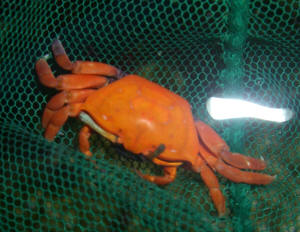 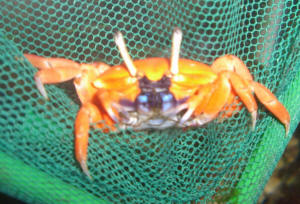
|
Crab ID please... Atergatopsis signatus, the
Giant Egg crab 9/28/07 Hi Guys... <Hi Jo, Mich
here. Sorry for the delay.> This crab hitched in on some live
rock a few months back... <Is a very pretty crab!> I've
been back and forth all over and I can't seem to get an ID on
him...His nippers aren't overly large, and he doesn't seem
to be doing any damage to corals or fish, <I hope this continues
to be the case, but crabs are never to be trusted.> I'm just
curious what he is so I know how big he will get...he started out
at around 1cm across his back and now, 6mths later he's around
3cm across his back... <Well, if my ID is correct, Atergatopsis
signatus, the Giant Egg crab, can reach up to 12 cm across!
That's pretty big for any aquarium. You may need to consider a
different home for this beauty. Do you have a nearby public
aquarium?> he is the most beautiful shade of lilac and very
smooth...he spends most of his time in a deep hole in the live rock
and comes out for a feed at night when I'm feeding the
tank...any ideas ??... <I do believe your crab may be a Giant
Egg crab (Atergatopsis signatus) but is hard to tell with just one
picture. You can see more images here. Particularly look at image #
4::
http://images.google.com/imgres?imgurl=http://decapoda.free.fr/images/brachyura/Atergatopsis_signata~_TAH_928-21.jpg&imgrefurl=http://decapoda.free.fr/illustration.php%3Fn%3D5%26sp%3D85&h=559&w=752&sz=83&hl=en&start=1&um=1&tbnid=28vhb-XTRuaakM:&tbnh=105&tbnw=141&prev=/images%3Fq%3DAtergatopsis%2Bsignatus%26svnum%3D10%26um%3D1%26hl%3Den%26safe%3Doff%26client%3Dsafari%26rls%3Den%26sa%3DG
> Cheers...
<And to you! Mich>
JO... |
|

|
|
Crab ID 8/9/07 Found this small (9.4mm wide
carapace) crab under the seaweed on Bailey Island, ME. Don't
recall seeing any with a red "V" before. Can you ID
please? David Reed <Looks like an unusually coloured European
shore crab, Carcinus maenas, to me. The 5-points on the either
side of the shell are indicative of that species, though not
unique to it. What is more telling is the pointed final segment
on the back pair of legs; on most of the similar crabs, these are
paddles: shore crabs are more fully adapted to terrestrial life
than most other intertidal crabs. The other "walking"
crabs like Hemigrapsus have fewer than five points on each side
of the shell. Despite its name, the European shore crab has been
transported all around the world, including both coasts of the
US, so finding one in Maine isn't unusual. They're
fascinating animals -- their species name, "maenas",
means "mad one", a reference to their amazing
fierceness and territoriality. They are very easy to keep in
marine or brackish water aquaria, though predatory. They can
survive exposure to dry air for days, and will tolerate
salinities down to almost (but not quite) freshwater. Anyway, I
could be wrong on the ID, so perhaps Bob or someone else will
chime in. Cheers, Neale.>
Re: Crab ID 8/9/07 Thanks for the quick
reply! David <Thanks for the thanks, but we don't actually
know if I'm right! Cheers, Neale>
|
|
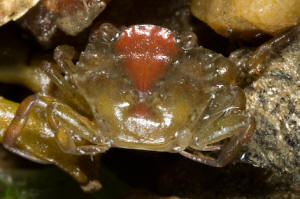
|
Crabs... and Ascidian, IDs -- 08/02/07
Hey Crew. <Hey now! Mich here.> It's been a long time
since I last wrote (about 3 days). <Heehee! That is a long time
from this email address!> I have some crabs in my display about
which I'm curious. Pics are attached. The first pic is just a
cool, very big sea squirt that I have--just a cool pic, no
question. <Neat!> The second pic is of a decorator crab (I
think Schizophrys dama). <Likely so.> It is small (maybe
1/4" tall) and I think it's a really cool crab (watching
him lumber about, etc.), but I also know your general feeling about
crabs. As you can see, he has poached some polyps from my tree
corals. I saw him molesting them tonight, although they didn't
seem to mind too much. <Hopefully he's just fragging it and
not noshing on it.> Anyway, question #1 is whether I should get
him out of the display and, if so, <He's not "reef
safe". whether I can put him in my 30g refugium (4-6" DSB
with 4lbs live rock and Chaeto)? <Could.> Will it eat my
pods/Chaeto? <I'm not sure. I'm not finding much on the
diet of this particular species but most crabs are opportunistic
omnivores.> I could put him in my 30g QT, but not much in there
for him to do. <This may be a good option.> Third pic is of
some type of filter feeding crab that I noticed tonight. Not a very
good picture, but it definitely has sweeper arms that it uses to
filter feed and you can clearly see its filters in the attached
pic. It doesn't look like any Porcelain Crab I've ever seen
(which is the only crab I found while researching that has similar
feather-like appendages). So, question #2 is any idea what type of
crab this is? <Is likely a Neopetrolisthes or Petrolisthes
species.> Final question (no pic) is the suitability of what I
think is a Mithrax forceps (Red-Ridged Clinging Crab). It came in
on some live rock and I've been observing it for several
months. It doesn't seem to molest anything other than the
little bit of macroalgae that I had (notice past tense) in my
display. <"Seem to molest" is likely an accurate
description... Most crabs are opportunistic omnivores.> Muchas
<De Nada!>
Andy
<Mich> |
|
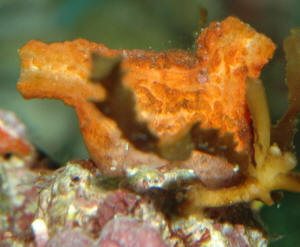
|
|
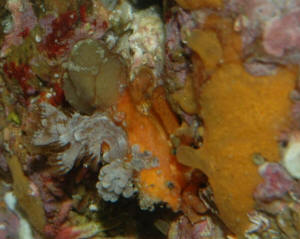 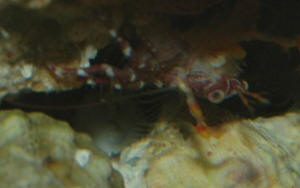
|
Stone Crabs! - 7/18/07 <Hi Bridget!> I have
pulled 3 of these guys out of my tank in the past 6 months.
<Yikes!> Pet store ID'd the last one and advised an
elimination program. All research on the web tells how tasty they are.
<I've never had them, but I've heard that as well.> That
really is kinda useless. <Well, if you do indeed have the same
variety of "stone crab" that they use in the seafood
industry, you can try Googling its scientific name: Menippe mercenaria.
That's the problem with common names, though. One name can be used
for many species.> My biggest question is, are they really all that
bad? <Well, not if you want a crab tank! If you want a reef tank
with snails, etc, in it, then yep, I'm sorry but they're bad.
Crabs in the Menippe genus are Xanthid, or mud, crabs and have a bad
reputation for being destructive in reef tanks. Also, some Xanthids are
toxic, so just in case, don't let anyone eat those crabs!> If so
what's your best advise for removal? <Please see this link and
the post labeled 'Trapping in Displays':
http://www.wetwebmedia.com/marine/inverts/arthropoda/crabs/swcrabfaqs2.htm
> I do know I no longer have any hermit crabs and my yellow tang has
gone missing? <Hmmmm, not good.> Now have 3 fish in the 75, 2
true Perculas and one coral beauty. Thank you for your time
Bridget <You're very welcome, and good luck! -Lynn>
Re: Stone Crabs! Follow-up 7/19/07 <Hi again,
Bridget! Lynn here.> Well I found some pictures here
http://www.okeefes.org/Crabs/crab%20photos%20and%20scans.htm and this
guy <(Pilumnus sayi)> is definitely what I have and not the stone
crabs <(Menippe mercenaria)> *Pilumnus sayi* <Thanks! Pilumnus
sayi, sometimes called the hairy mud crab, or spineback hairy crab, has
those same robust claws as the yummy stone crabs (Menippe mercenaria)
but with lots of bristles! Unfortunately, it's still a Xanthid and
potential trouble down the road for a mixed reef tank.> Hubby is
being a grump and not wanting to remove these guys. <I can
understand that. As much trouble as they can cause for the other
inhabitants of your tank, they're still neat little creatures! Why
not set up a separate tank for them? It's a win-win!> Myself,
I'm more than concerned about the quantity and I'm wondering if
they might be reproducing or if they just came in with the live rock.
<Almost guaranteed that they came in with the rock. The juvenile
stages of crabs have a next to nil chance of surviving in the average
tank.> I don't see these guys. They're professional hiders,
<Yes indeed!> I'm only finding dead bodies. <Of snails,
etc, or the crabs themselves? If it's snails, etc, that's not
too surprising. If it's crab bodies, they could just be the shed
shells from when they molt.> Which makes me more concerned about
anyone else in the tank. <Understandable either way!> Tank is a
75 reef established 3 years, new live rock with oysters 6 months ago.
<Sounds like a nice tank to me!> Thank you for your time. Bridget
<You're most welcome, Bridget. I'd try to trap these guys
(see previous link on this) and set them up in a tank of their own.
Good luck! -Lynn >
| CRAB ID... Yum! 7/16/07 Good
Morning, <And to you! Mich here.> This is my first question
for the Crew; however you forum has saved me hundreds of dollars
and too numerous hours with the information posted on you website.
<Very good to hear!> I am trying to ID a crab in my tank. He
was in a deep hole in a piece of LR and he only came out at night.
He finally got too big for the hole and I managed to get he
cornered in another piece of LR. anyway can you help ID this little
critter. <Mmm, boy I'm not really sure I can even get this
crab to the family level, my guess would be this might be Family
Cancridae and it does resemble the Red Rock crab (Cancer
antennarius) picture posted on the site... Same family as the
Dungeness Crabs. But is more of a guess than an ID.
http://www.wetwebmedia.com/marine/inverts/arthropoda/crabs/swcrabs.htm
I would doubt that it is reef safe or fish friendly by the size of
the claws. Look more like the type you might eat than keep as a
pet. I would certainly house him out of the display. Perhaps the
refugium or maybe your local Red Lobster would be a more suitable
home?> Paul <I suppose it would be just outright wrong to ask
if you had any drawn butter? Heehee! Mich> |
|

|
Crab ID and Clown/Anemone Question --
07/03/07 Crew, Sorry to lump two different subjects in the same
e-mail, but thought it would save you some time. I purchased 65lbs
or live rock (50 lbs Fiji/Marshall and 15lbs Florida) about 5
months ago. In the last week or so, I noticed two crabs that
hitchhiked in. My face is pressed against the glass every night, so
I'm really surprised I haven't seen these crabs until
recently (although my tank is 110g). I have attached pictures.
I'm pretty sure the first picture is of a sponge crab, genus
Schizophrys. It is pretty small and is covered with pieces of
orange sponge. The second two pictures are of the same crab.
It's hard to get a good shot of it, but it is pretty small
(maybe 1/2") and relatively flat with hairy legs. It's
claws are pretty small. I've searched the web and WWM but
can't find a picture that looks like either of these crabs. My
closest guess on the second is the Schizophrys aspera. <Appears
to be...> Should I remove these? <Mmm, not yet> Currently,
I don't have much in the way of fishes or inverts. One gold
banded maroon clown, one BTA, two cleaner shrimp, a pretty good
sized clean-up crew, and a Sailfin tang in QT. I intend to stick
with smallish fish (but not tiny) and some soft corals. When I
bought my clown, he was loving life in a BTA. Since I've had
him, though, he's spent much of his life in a hospital tank
while my display went fallow for 4+ weeks. I recently introduced
him back into the tank and he shows no interest in my BTA.
<Takes time...> My BTA is tucked under a rock at the bottom
of the tank, but definitely visible, flowing, calling out to his
friend, but the clown seems totally uninterested. I find this
strange since he was in a BTA when I purchased him. I would love
for them to have a hot, lovely relations. Do clowns find anemones
by scent, sight, some combination of the two, or none of the two?
<Good question... I don't know... perhaps a bit of both...
It is known that the fish DO communicate with the Anemones
chemically> Are clowns fickle, or can it take weeks or longer
for the clown to settle in and accept a BTA? <I suspect both...
plus a bit autistic... have short memories...> As always, your
thoughts are appreciated. Andy
<Welcome. Bob Fenner> |
|

|
|
|

